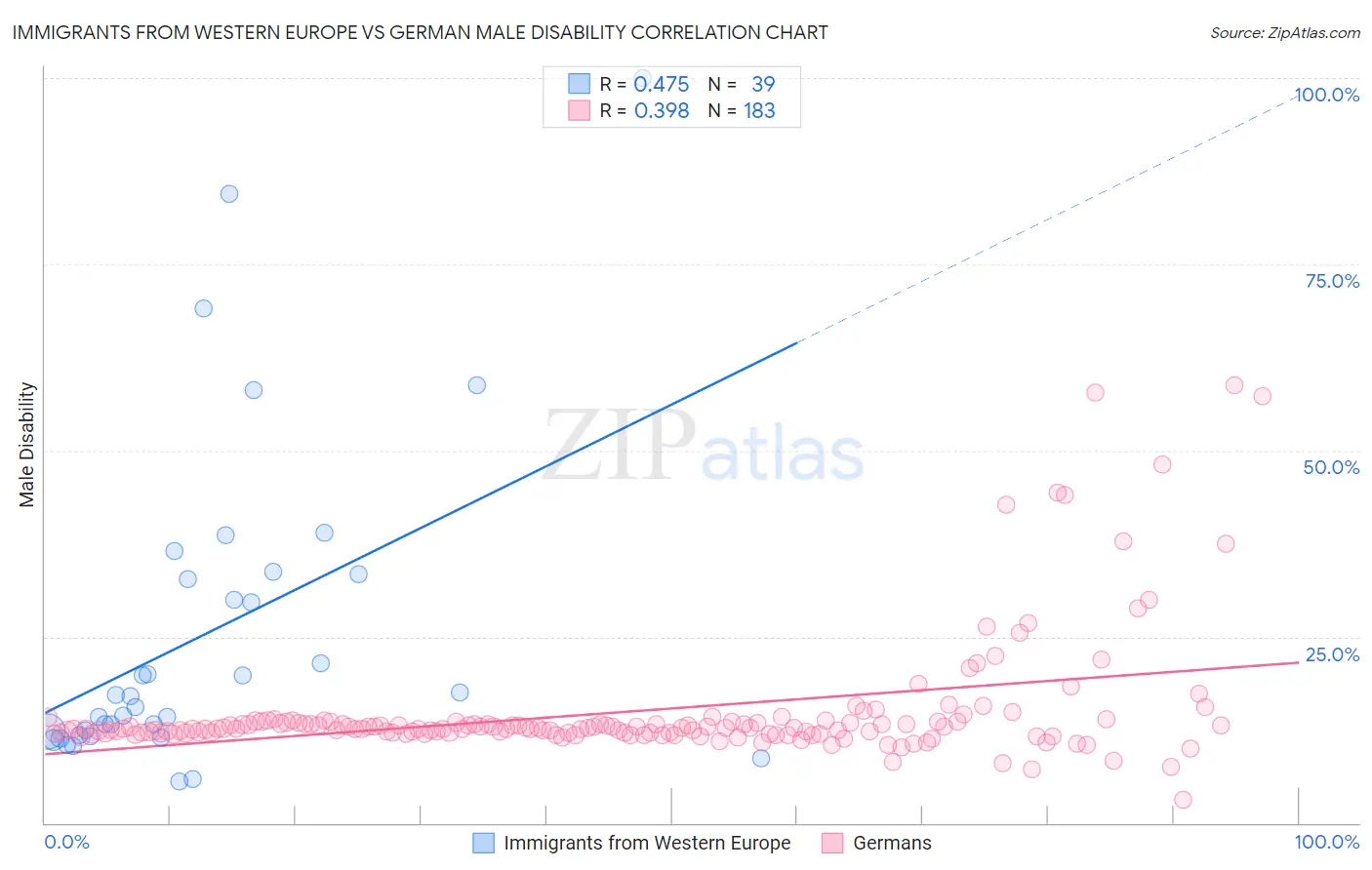Immigrants from Western Europe vs German Male Disability
COMPARE
Immigrants from Western Europe
German
Male Disability
Male Disability Comparison
Immigrants from Western Europe
Germans
11.7%
MALE DISABILITY
3.8/ 100
METRIC RATING
220th/ 347
METRIC RANK
12.7%
MALE DISABILITY
0.0/ 100
METRIC RATING
283rd/ 347
METRIC RANK
Immigrants from Western Europe vs German Male Disability Correlation Chart
The statistical analysis conducted on geographies consisting of 494,010,238 people shows a moderate positive correlation between the proportion of Immigrants from Western Europe and percentage of males with a disability in the United States with a correlation coefficient (R) of 0.475 and weighted average of 11.7%. Similarly, the statistical analysis conducted on geographies consisting of 580,769,413 people shows a mild positive correlation between the proportion of Germans and percentage of males with a disability in the United States with a correlation coefficient (R) of 0.398 and weighted average of 12.7%, a difference of 8.5%.

Male Disability Correlation Summary
| Measurement | Immigrants from Western Europe | German |
| Minimum | 5.5% | 3.0% |
| Maximum | 100.0% | 58.8% |
| Range | 94.5% | 55.8% |
| Mean | 25.6% | 14.9% |
| Median | 17.1% | 12.7% |
| Interquartile 25% (IQ1) | 11.8% | 12.1% |
| Interquartile 75% (IQ3) | 33.3% | 13.5% |
| Interquartile Range (IQR) | 21.6% | 1.4% |
| Standard Deviation (Sample) | 21.7% | 8.3% |
| Standard Deviation (Population) | 21.4% | 8.3% |
Similar Demographics by Male Disability
Demographics Similar to Immigrants from Western Europe by Male Disability
In terms of male disability, the demographic groups most similar to Immigrants from Western Europe are Panamanian (11.7%, a difference of 0.010%), Immigrants from Congo (11.7%, a difference of 0.010%), Immigrants from England (11.7%, a difference of 0.070%), Alsatian (11.7%, a difference of 0.17%), and Immigrants from Bahamas (11.7%, a difference of 0.25%).
| Demographics | Rating | Rank | Male Disability |
| Mexican American Indians | 7.8 /100 | #213 | Tragic 11.6% |
| Lithuanians | 6.6 /100 | #214 | Tragic 11.6% |
| Indonesians | 5.9 /100 | #215 | Tragic 11.6% |
| Immigrants | Dominican Republic | 4.9 /100 | #216 | Tragic 11.7% |
| Immigrants | Dominica | 4.6 /100 | #217 | Tragic 11.7% |
| Immigrants | England | 4.0 /100 | #218 | Tragic 11.7% |
| Panamanians | 3.8 /100 | #219 | Tragic 11.7% |
| Immigrants | Western Europe | 3.8 /100 | #220 | Tragic 11.7% |
| Immigrants | Congo | 3.7 /100 | #221 | Tragic 11.7% |
| Alsatians | 3.3 /100 | #222 | Tragic 11.7% |
| Immigrants | Bahamas | 3.2 /100 | #223 | Tragic 11.7% |
| Japanese | 3.1 /100 | #224 | Tragic 11.7% |
| Liberians | 3.1 /100 | #225 | Tragic 11.8% |
| Sub-Saharan Africans | 2.8 /100 | #226 | Tragic 11.8% |
| Austrians | 2.5 /100 | #227 | Tragic 11.8% |
Demographics Similar to Germans by Male Disability
In terms of male disability, the demographic groups most similar to Germans are Irish (12.7%, a difference of 0.010%), Sioux (12.7%, a difference of 0.070%), Dutch (12.7%, a difference of 0.12%), Slovak (12.7%, a difference of 0.17%), and Spanish (12.7%, a difference of 0.27%).
| Demographics | Rating | Rank | Male Disability |
| Africans | 0.0 /100 | #276 | Tragic 12.6% |
| Finns | 0.0 /100 | #277 | Tragic 12.6% |
| Central American Indians | 0.0 /100 | #278 | Tragic 12.7% |
| Slovaks | 0.0 /100 | #279 | Tragic 12.7% |
| Dutch | 0.0 /100 | #280 | Tragic 12.7% |
| Sioux | 0.0 /100 | #281 | Tragic 12.7% |
| Irish | 0.0 /100 | #282 | Tragic 12.7% |
| Germans | 0.0 /100 | #283 | Tragic 12.7% |
| Spanish | 0.0 /100 | #284 | Tragic 12.7% |
| Welsh | 0.0 /100 | #285 | Tragic 12.7% |
| Scottish | 0.0 /100 | #286 | Tragic 12.8% |
| Cape Verdeans | 0.0 /100 | #287 | Tragic 12.8% |
| Yup'ik | 0.0 /100 | #288 | Tragic 12.8% |
| Immigrants | Cabo Verde | 0.0 /100 | #289 | Tragic 12.8% |
| Pima | 0.0 /100 | #290 | Tragic 12.8% |